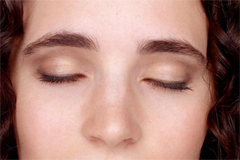Eyelid Treatments
Ptosis
Ptosis is a condition in which the eyelid droops. It is caused by a weakness or separation of muscles deep within the eyelid. Ptosis does not involve excess skin or tissue in the eyelid (a condition called dermatochalasis). It is usually a result of aging, but some people develop ptosis after eye surgery or an injury, and some children are born with the condition. A brief surgical procedure can eliminate the drooping. Many young patients with mild to moderate ptosis do not need surgery early in life. Patients who are also suffering from excess skin may choose to undergo blepharoplasty at the same time as ptosis repair. Children with ptosis should be examined regularly to check for other vision problems including amblyopia (“lazy eye”), refractive errors and muscular diseases.
Blepharoplasty
 Blepharoplasty can rejuvenate puffy, sagging or tired-looking eyes by removing excess fat, skin and muscle from the upper and lower eyelids. It may be performed for cosmetic reasons or to improve sight by lifting droopy eyelids out of the patient’s field of vision. Blepharoplasty can be combined with BOTOX® treatments to raise the eyebrows or reduce the appearance of wrinkles, crow’s feet or dark circles under the eyes.
Blepharoplasty can rejuvenate puffy, sagging or tired-looking eyes by removing excess fat, skin and muscle from the upper and lower eyelids. It may be performed for cosmetic reasons or to improve sight by lifting droopy eyelids out of the patient’s field of vision. Blepharoplasty can be combined with BOTOX® treatments to raise the eyebrows or reduce the appearance of wrinkles, crow’s feet or dark circles under the eyes.
The procedure is usually performed in an office with local anesthesia and lasts 45 minutes to a few hours depending on how much work is done. Incisions are made along the eyelids in inconspicuous places (in the creases of the upper lids, and just below the lashes on the lower lids). The surgeon removes excess tissue through these incisions and then stitches them closed with fine sutures. In the case that no skin needs to be removed, the surgeon will likely perform a transconjunctival blepharoplasty, where the incision is made inside the lower eyelid and there are no visible scars.
Stitches are removed after a week and most people return to work relatively soon after the procedure. Contact lenses may not be worn for two weeks. The effects of blepharoplasty can last for a long time and are sometimes even permanent.
Ectropion/Entropion Repair
Ectropion is a “turning out” of the eyelid that causes redness, irritation, tearing and an increased likelihood of infection. Common causes of ectropion include aging, sun damage, tumors, burns and the removal of too much skin during blepharoplasty. Artificial tears can help provide temporary relief from dryness. Ectropion can be corrected in a quick procedure in which the lid is tightened. Occasionally, the surgeon needs to graft a small segment of skin to ensure that the eyelid is fully repaired.
Entropion is a “turning in” of the eyelid. The lid and lashes rub painfully against the cornea. Entropion usually occurs as a result of aging, but other causes can include injury, congenital defect and various inflammatory conditions. A spasm can cause the lid to turn inward. Entropion can be corrected with a brief surgical procedure under local anesthesia.
BOTOX® Cosmetic
 BOTOX® Cosmetic is commonly used to reduce or eliminate the appearance of facial wrinkles. It is injected under the skin into areas surrounding the eyes, forehead and mouth to smooth crow’s feet, frown and worry lines, and lines on the neck. Made from a purified protein, BOTOX® relaxes wrinkles and gives the face a rejuvenated look. BOTOX® may also be useful for migraine headaches, excessive sweating, and eye and neck muscle spasms.
BOTOX® Cosmetic is commonly used to reduce or eliminate the appearance of facial wrinkles. It is injected under the skin into areas surrounding the eyes, forehead and mouth to smooth crow’s feet, frown and worry lines, and lines on the neck. Made from a purified protein, BOTOX® relaxes wrinkles and gives the face a rejuvenated look. BOTOX® may also be useful for migraine headaches, excessive sweating, and eye and neck muscle spasms.
Juvéderm®
 Juvéderm® Injectable Gel is a safe, effective gel that restores volume to the skin and smoothes away moderate to severe facial wrinkles and folds. Juvéderm® is the first FDA-approved dermal filler proven safe and effective for persons of color. The Juvéderm® gel is made of hyaluronic acid with a smooth consistency, allowing for easy injections and instant, natural-looking results. There is no pre-testing needed for this procedure.
Juvéderm® Injectable Gel is a safe, effective gel that restores volume to the skin and smoothes away moderate to severe facial wrinkles and folds. Juvéderm® is the first FDA-approved dermal filler proven safe and effective for persons of color. The Juvéderm® gel is made of hyaluronic acid with a smooth consistency, allowing for easy injections and instant, natural-looking results. There is no pre-testing needed for this procedure.
Topical or injectable anesthesia may be used during this procedure to numb the treatment area and minimize any potential discomfort. The results of this procedure are available right away and can usually last for up to a year, the longest results available from any hyaluronic acid product.


